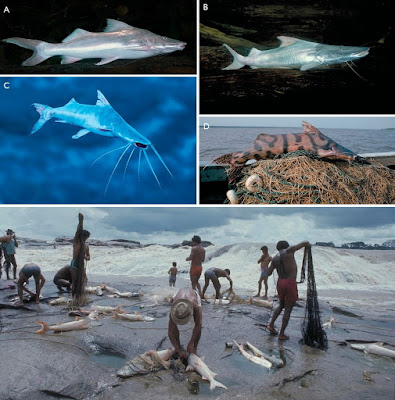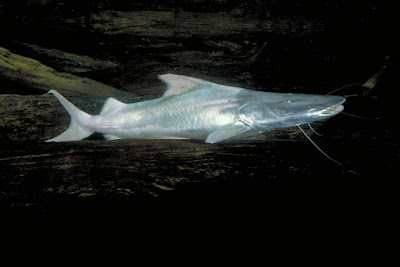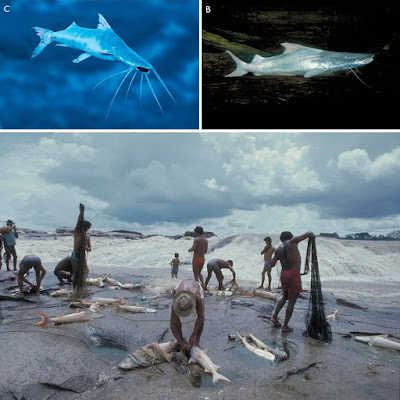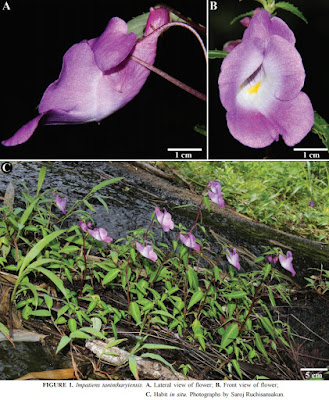[Most Recent Entries] [Calendar View]
Wednesday, February 15th, 2017
| Time | Event | ||
| 5:22a | [Ichthyology • 2017] Goliath Catfish (Brachyplatystoma spp., Pimelodidae) Spawning in the far western Amazon confirmed by the Distribution of Mature Adults, Drifting Larvae and Migrating Juveniles
Abstract We mapped the inferred long-distance migrations of four species of Amazonian goliath catfishes (Brachyplatystoma rousseauxii, B. platynemum, B. juruense and B. vaillantii) based on the presence of individuals with mature gonads and conducted statistical analysis of the expected long-distance downstream migrations of their larvae and juveniles. By linking the distribution of larval, juvenile and mature adult size classes across the Amazon, the results showed: (i) that the main spawning regions of these goliath catfish species are in the western Amazon; (ii) at least three species — B. rousseauxii, B. platynemum, and B. juruense — spawn partially or mainly as far upstream as the Andes; (iii) the main spawning area of B. rousseauxii is in or near the Andes; and (iv) the life history migration distances of B. rousseauxii are the longest strictly freshwater fish migrations in the world. These results provide an empirical baseline for tagging experiments, life histories extrapolated from otolith microchemistry interpretations and other methods to establish goliath catfish migratory routes, their seasonal timing and possible return (homing) to western headwater tributaries where they were born. Ronaldo B. Barthem, Michael Goulding, Rosseval G. Leite, Carlos Cañas, Bruce Forsberg, Eduardo Venticinque, Paulo Petry, Mauro L. de B. Ribeiro, Junior Chuctaya and Armando Mercado. 2017. Goliath Catfish Spawning in the far western Amazon confirmed by the Distribution of Mature Adults, Drifting Larvae and Migrating Juveniles. Scientific Reports. 7, Article number: 41784. DOI: 10.1038/srep41784 Extraordinary migration of giant Amazon catfish revealed theguardian.com/environment/2017/feb/07/e Giant catfish clocks longest ever freshwater migration https://news.mongabay.com/2017/02/giant-c Scientists confirm dorado catfish as all-time distance champion of freshwater migrations scienmag.com/scientists-confirm-dorado-c | ||
| 7:54a | [Botany • 2017] Impatiens tanintharyiensis • A New Species (Balsaminaceae) from Southern Myanmar
Abstract Impatiens tanintharyiensis Ruchisansakun, Suksathan & Saw-Lwin from the Tanintharyi region of Southern Myanmar is described and illustrated as a new species. The presence of connate lateral united petals and a four-locular ovary, as well as results of molecular phylogenetic analyses of nuclear ITS and plastid atpB-rbcL spacer DNA sequences, suggest that the new species is a member of Impatiens section Semeiocardium (Zoll.) S.X. Yu & Wei Wang. The new species is morphologically most similar to I. spectabilis Triboun & Suksathan, but can be distinguished by its asymmetric flowers, saccate-bucciniform lower sepal, and shorter, slightly incurved spur. Floral traits, including the presence of a large floral chamber with a wide entrance, are consistent with the bee-pollination syndrome in Impatiens. Since I. tanintharyiensis is only known from two small populations, its conservation status is assessed as Endangered. Keywords: floral asymmetry, Impatiens, lithophyte, Myanmar, Semeiocardium, taxonomy, Eudicots Impatiens tanintharyiensis Ruchisansakun, Suksathan & Saw-Lwin is morphologically similar to I. spectabilis Triboun & Suksathan but can be distinguished by having asymmetric flowers due to anticlockwise distorted lateral united petals, a saccate-bucciniform lower sepal, and a shorter, slightly incurved spur. Type:— MYANMAR. Tanintharyi Region: Dawei, Thet Kal Kwet Village. ... Distribution:— Endemic to Southern Myanmar (Tanintharyi Region), only known from two localities. Ecology:— Growing among decaying organic material on low granular metamorphic rock of granitic schist facies (Phongphat Prasong, pers. comm), along a waterfall at 146–155 m above sea level. Etymology:— The specific epithet refers to its locality, the Tanintharyi region of Myanmar. Common name:— Tanintharyi Dan Pan, Tanintharyi balsam. Pollination ecology:— A recent comparative study of floral morphology and pollination ecology demonstrated that the closely related and morphologically similar I. daraneenae, is pollinated by bees (Ruchisansakun et al. 2016). The presence of a large floral chamber with a wide entrance are traits associated with bee pollination in Southeast Asian Impatiens (Ruchisansakun et al. 2016). Based on the traits of the new species, we hypothesize that the new species is also bee-pollinated. Saroj Ruchisansakun, Piyakaset Suksathan, Timotheüs van der Niet, Saw Lwin and Steven B. Janssens. 2017. Impatiens tanintharyiensis (Balsaminaceae), A New Species from Southern Myanmar. Phytotaxa. 296(2); 171–179. DOI: 10.11646/phytotaxa.296.2.6 |
| << Previous Day |
2017/02/15 [Calendar] |
Next Day >> |








